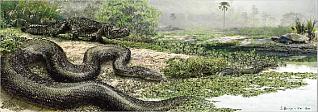If you look in the records there is a lot of controversy over which snake holds the world's record for massive size. The dimensions that have earned the anaconda the title of king is its total body mass or its weight (the sheer physical bulk of it). The largest anaconda ever measured was almost 28 feet long with a girth of 44 inches. She wasn't weighed at the time she was caught, but scientists estimate that she must have weighed over 500 lbs. The other snake that competes with the anaconda is the Asiatic Reticulated Python (Python reticulatus). The python holds the world's record for length of a snake, with the longest ever measured at 33 feet. Even though the longest python is longer than the record-holding anaconda, the girth of the anaconda is far bigger. Anacondas in the jungles of South America can grow as big around as a grown man!
If you've seen the stories circulating around the Internet about the world's biggest snake being held in captivity in Indonesia (back in 2003), then get the straight dope on snopes.com.
The Secret Life of an Anaconda
 Anacondas in the wild spend most of their time hanging out in rivers hunting for their food. They are solitary creatures that are somewhat shy and not many of them are easily seen. They are very well camouflaged in the swamps and bogs in which they thrive. There are some historical reports of early European explorers of the South American jungles seeing giant anacondas up to 100 feet long and some of the native peoples of the South American jungle have reported seeing anacondas up to 50 feet long. No one has caught and measured an anaconda anywhere near that size. It is important to note that when a dead anaconda's hide or skin is laid out it can be stretched very easily, expanding to much longer lengths than the snake exhibited when alive. Reports of outsize anacondas that cannot be verified are usually due to distortions in perception, or a snake skin being disproportionately stretched and inaccurately measured. People are generally really bad at estimating length, especially for larger snakes. In fact, the larger the snake, the larger the margin of error.
Anacondas in the wild spend most of their time hanging out in rivers hunting for their food. They are solitary creatures that are somewhat shy and not many of them are easily seen. They are very well camouflaged in the swamps and bogs in which they thrive. There are some historical reports of early European explorers of the South American jungles seeing giant anacondas up to 100 feet long and some of the native peoples of the South American jungle have reported seeing anacondas up to 50 feet long. No one has caught and measured an anaconda anywhere near that size. It is important to note that when a dead anaconda's hide or skin is laid out it can be stretched very easily, expanding to much longer lengths than the snake exhibited when alive. Reports of outsize anacondas that cannot be verified are usually due to distortions in perception, or a snake skin being disproportionately stretched and inaccurately measured. People are generally really bad at estimating length, especially for larger snakes. In fact, the larger the snake, the larger the margin of error.Anacondas like to hang out in rivers so it would be difficult to estimate the length of one seen swimming without seeing the entire snake. It's the anaconda's ability to remain partly hidden in the water that makes it difficult to accurately find (and document) a specimen that exceeds the current world's record. (Would you want to jump in the water after a giant anaconda to try and measure a snake big enough to kill you?)
 The Biggest Snake to Have Ever Lived
The Biggest Snake to Have Ever LivedIf you think that an anaconda big enough to swallow a capybara or tapir whole is big, you should see the size of the giant snake scientists discovered in a coal mine in Columbia, South America in 2008. Fossils of an enormous snake were discovered in an open coal mine in the Amazon rainforest. Paleontologists estimated the length of the snake to be 43 feet long and estimated to weigh 2,500 pounds! Based on their findings, the scientists who identified this new species of snake said it was large enough to prey on crocodiles. Since snakes are cold-blooded, the average temperature of the Amazon had to have been 6 to 8 degrees warmer to support a snake that enormous.
Killer SnakeAnacondas are members of the boa constrictor family of snakes. That means that they kill their prey by coiling their large, powerful bodies around their victims and squeezing until their prey suffocates or is crushed to death and dies from internal bleeding. Then the snake unhinges its jaw and swallows the victim whole. Anacondas are much more likely to eat aquatic creatures, such as fish. Occasionally, they have been known to eat: caimans (a relative of the alligator), other snakes, deer, and even jaguars. Anacondas are rather slow-moving snakes, so they have to rely on stealth and the element of surprise to catch their unsuspecting prey.
Do Anacondas Bite? Just about every species of snake on earth has teeth, but the anacondas' teeth are not used for chewing. Snakes' teeth are used for holding onto their prey, preventing them from escaping. Some snakes have venom in two specially designed, extra long teeth (called fangs) which they use to kill their prey. Anacondas have teeth, but they are not a venomous snake. They rely on their enormous size and power to subdue their victims. It is possible to be bitten by an anaconda, but the bite itself would not be fatal.
No comments:
Post a Comment